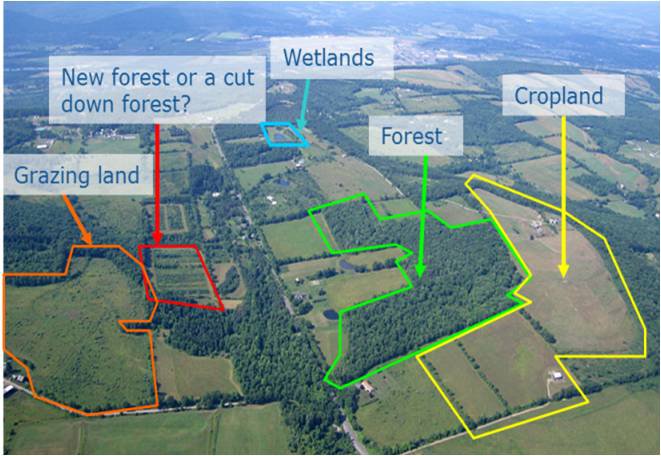Land Use, Land Use Change and Forestry
Background
The long-term temperature goal of the Paris Agreement, i.e. keeping “the increase in the global average temperature to well below 2 °C”, requires achieving “a balance between global anthropogenic greenhouse gas (GHG) emissions by sources and removals by sinks in the second half of this century”. At present, the management of terrestrial ecosystems (mainly forests) remains the main tool we have to remove CO2 from the atmosphere and therefore to “balance” the GHG emissions.
This expectation on land-based mitigation is reflected also in countries’ targets under the Paris Agreement, where forests are assumed to provide up to a quarter of planned emission reductions by 2030. While most of the mitigation potential is on reduced emissions from deforestation in the tropics, the management of existing forest also offers a rich portfolio of options, including conserving and enhancing the current CO2 sink and using wood-based products to reduce emissions in other sectors through material and energy substitution.
Under the UN Framework Convention on Climate Change (UNFCCC), countries prepare inventories of all anthropogenic GHGs emissions and removals, following the methodological guidance prepared by the Intergovernmental Panel on Climate Change (IPCC). These GHG inventories include the “Land Use, Land-Use Change and Forestry” (LULUCF) sector, encompassing emissions and removals mainly from forests, but also from cropland, grasslands, wetlands, settlements and other lands.
The estimation of LULUCF GHG emissions and removals is more complex and uncertain than in other GHG sectors (e.g., energy, agriculture), because it can be hard to disentangle the simultaneous natural and anthropogenic processes that determine land-related fluxes. Moreover, unlike other sectors, assessing the atmospheric impact of additional actions in forestry is difficult, because GHG fluxes change over time as a result of forest age-related dynamics, which is largely determined by past forest management and natural disturbances.
At the EU level, the LULUCF sector acts CO2 sink (mainly by forests) offsetting about 7% of the GHG emissions from the other sectors. Given the importance of this sector for climate mitigation, the recent Regulation 2018/841 included LULUCF in the EU 2030 climate target under the Paris Agreement (i.e., a reduction of GHG emissions by 40% in 2030 relative to 1990), through a set of specific “accounting rules” to assess the impact of land-related mitigation actions.
LULUCF activities at JRC
Under the Bioeconomy Unit, the LULUCF group aims to provide science-based support to Commission’s services (mainly DG CLIMA) in understanding how forests mitigate and interact with climate change in the context of EU and international climate policies.
Specifically, our LULUCF-related activities include:
1. Support the design of LULUCF policies at EU and UNFCCC level. Examples include having provided the scientific background for the new rules accounting for the atmospheric impact of forest activities under Regulation 2018/841 (through the so-called ‘forest reference levels’), and technical support for the negotiations of the Paris Agreement and its Rulebook.
2. Support the measuring and reporting of LULUCF emissions and removals, including:
- In the context of the EU GHG Monitoring Mechanism for evaluating the compliance of EU Member States with the EU legislation and the UNFCCC requirements (including the Kyoto Protocol till 2020, and the Paris Agreement after 2020), we coordinate the LULUCF chapter of the EU National Inventory Report and help Member States in improving the quality of their GHG inventories, through specific projects and workshops;
- We participate to the annual UNFCCC reviews of GHG inventories;
- We contribute as Lead and Contributing authors to the update of the IPCC methodological guidance for national GHG inventories;
- We are developing a new LULUCF module of the EDGAR database;
- We bridge gaps between science and policy, e.g. reconciling global-model estimates and country reporting of anthropogenic forest CO2 sinks for the purpose of implementing the Paris Agreement’s Global Stocktake.
3) Forest modeling through the implementation of the Carbon Budget Model (CBM-CFS) to estimate the past and future forest carbon dynamics and biomass availability in EU countries following the IPCC guidance. This model contributes also to the Bioeconomy Modelling in the Bioeconomy Unit, aimed at studying the interactions between forest dynamics and economic processes, and assessing social and environmental impacts.

Further LULUCF related information can be found in the following subsections:
- Workshops: outcomes from last years’ workshops aimed to address technical issues related to the reporting of GHG emissions/removals from LULUCF.
- IPCC Classifications: country-specific climate, soils and global ecological zones classification to support the selection of IPCC default factors.
- Presentations: a summary of relevant presentations addressing different LULUCF related issues.
- JRC note on Nature paper : Note on the JRC Nature paper on harvest, complementing the reply of Ceccherini et al. 2021.
Contact: JRC-FOREST[at]ec.europa.eu

